Storage and Care Tips for Your 1-Kilo Silver Bar: Complete Guide
Posted on — Leave a commentOne improperly stored 1-kilo silver bar can lose hundreds in resale value from tarnish alone. Unlike gold, silver is highly reactive and vulnerable to humidity, sulfur, and temperature shifts. Once tarnished, the damage is permanent: buyers discount heavily, and liquidity suffers. The good news, however, is that preventing this is simple. With the right storage, handling, and environmental controls, investors can keep their silver in investment-grade condition. This guide explains why silver demands unique care, giving you the exact steps to preserve the value, appearance, and marketability of your 1-kilo bars.
What Is a 1-Kilo Silver Bar
A 1-kilo silver bar is a global benchmark for serious silver investors, combining cost efficiency, purity, and manageable size.
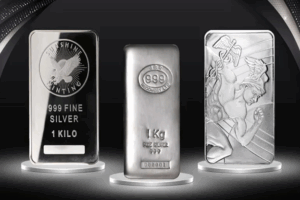
Image: Different examples of 1-kilo silver bars, showing variations in design and finish.
Source: Rethinking The Future
Metric Standard
The 1,000-gram format gained prominence in the late 20th century as international silver trading expanded beyond traditional imperial systems. European and Asian refineries led this shift, finding metric measurements simplified cross-border transactions and inventory management. Today, major exchanges and dealers recognize a 1-kilo bar of silver as a standard investment unit, making these bars highly liquid in global markets.
Ounce Conversion
Each 1-kilo bar of silver contains exactly 32.15 troy ounces of silver. This matters particularly for American investors accustomed to thinking in ounces: a 1-kilo bar equals roughly 32 American Silver Eagles or three 10-ounce bars. This conversion knowledge helps when comparing premiums across different product sizes and calculating portfolio allocations.
Purity Specifications
While .999 fine silver (99.9% purity) has become the accepted minimum for investment-grade bars, some older or industrial bars may contain .925 or .950 silver. Investment-grade purity ensures immediate recognition by dealers and maintains consistent melt values across different manufacturers.
Investment Positioning
The 1-kilo bar of silver format targets serious investors seeking lower premiums without institutional-level commitments. These bars offer significantly better pricing than smaller denominations while avoiding the storage challenges of massive commercial bars. Unlike 100-ounce bars that demand specialized vaults, 1-kilo bars fit standard home safes and remain light enough for personal handling and transport.
Watch this visual guide to silver bar stacking to see how 1 kilo bars fit into a broader precious metals strategy.
1-Kilo Silver Bar Physical Specifications
A 1-kilo silver bar weighs 2.2 pounds and typically measures roughly the size of a large smartphone, but significantly thicker and denser.
Exact Measurements
Typical dimensions are around 114mm × 57mm × 13mm (4.5″ × 2.25″ × 0.5″), though 1-kilo silver bar size varies slightly by manufacturer. Minted bars are more uniform, while cast bars may be chunkier or irregular. These compact dimensions make kilo bars stackable in most home safes and easy to handle with one hand.
Weight Precision
Most investment-grade kilo bars fall within ±1-2 grams of the stated 1,000 g weight. This precision when it comes to 1-kilo silver bar weight ensures accurate precious metals calculations and meets exchange standards for trading and storage facility acceptance.
Surface Characteristics
Silver bars come in two main finishes: cast and minted (also called pressed). Cast bars are poured into molds, creating rougher, textured surfaces that hide minor scratches but show fingerprints easily. Pressed bars undergo additional machining for mirror-like finishes that display scratches prominently but their smooth surfaces leave fewer crevices where tarnish and contaminants can settle, helping them maintain a cleaner appearance over time.
Silver Density
Silver’s lower density (10.49 g/cm³) compared to gold (19.32 g/cm³) means 1-kilo silver bars appear significantly larger than equivalent-weight gold bars, requiring more storage space and different stacking considerations for vault organization.
Major 1-Kilo Silver Bar Manufacturers
Not all 1-kilo silver bars offer equal liquidity or recognition. Manufacturer reputation directly affects resale ease and buyer confidence. Learn more about purchasing investment-grade bars from reputable refineries.
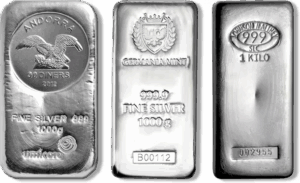
Image: Examples of 1-kilo silver bars from Umicore, Germania Mint, and Johnson Matthey.
Source: Blanchard
Johnson Matthey Leadership
Johnson Matthey, refining precious metals since 1817, built unmatched credibility in global markets. In 2015, the company sold its bullion division to Asahi Refining, but existing Johnson Matthey 1-kilo silver bar bullion remains highly liquid. With distinctive serial numbering and security elements that make counterfeiting difficult, these bars continue to command premiums worldwide. Dealers instantly recognize their quality standards and trust their resale value. Johnson Matthey held LBMA Good Delivery accreditation, ensuring its bars met the strictest standards for weight, purity, and appearance.
Germania Mint
Germania Mint, established in 2018 by Poland’s Kurowski Group, combines traditional European craftsmanship with modern production techniques. Germania mint 1-kilo silver bar bullion features the distinctive Germania figure, symbolizing the historic central European region, along with detailed design elements that set them apart from generic bullion. Struck to .9999 purity, these bars reflect consistent quality and modern finishing standards. Though relatively new, Germania has gained rapid acceptance among collectors and investors, particularly in European markets where its cultural imagery resonates strongly.
Umicore
This Belgian refining giant brings industrial-scale precision to precious metals production. Umicore’s 1-kilo silver bars feature clean, professional designs with advanced security elements including unique serial numbering and secure packaging options depending on size. The company’s extensive experience in metals processing ensures consistent quality and purity standards. Umicore bars have established strong recognition among European dealers and are increasingly accepted in international precious metals markets.
Other Notable Refineries
The refiners highlighted above are only part of the global bullion landscape. Across Europe and beyond, several LBMA-accredited refiners produce 1-kilo silver bars that enjoy strong dealer recognition and investor trust. PAMP Suisse, with its Fortuna design and Veriscan technology, and Metalor, known for its century of refining heritage and clean, consistent bar designs, are two leading examples. Others, such as Valcambi, Heraeus, and Argor-Heraeus, likewise uphold the highest standards of weight, purity, and security, ensuring their kilo bars remain highly liquid across international markets.
Storage Requirements and Environmental Factors
Silver’s reactive chemistry makes environmental control the most critical factor in preserving your 1-kilo silver bar value and condition. Learn more about comprehensive storage strategies for precious metals.
Tarnishing Prevention
Humidity above 50% accelerates tarnish by helping sulfur compounds bond with silver. Everyday sources, like heating systems, cleaning agents, rubber, wool, or cigarette smoke, release these particles into the air. Combined with moisture, they form silver sulfide, leaving permanent black spots. Maintaining low humidity and clean air prevents these reactions and preserves silver’s appearance.
Temperature Control
Consistent temperatures between 60-70°F work best for silver storage. Fluctuations create condensation, which leads to spotting and tarnish, and can also stress protective packaging over time. Basements and attics with wide swings in heat or cold pose particular risks to long-term preservation.
Container Selection
Airtight containers prevent airborne contaminants from reaching silver surfaces but can trap moisture if not properly prepared. Breathable storage allows air circulation but offers less protection from environmental pollutants. The choice depends on your specific storage environment and climate control capabilities.
Stacking Methods
How silver bars are stacked directly impacts their condition over time. Placing bars in direct metal-to-metal contact can cause scratches, surface wear, and pressure marks. Using protective separators, such as soft cloth, mylar sheets, or original packaging, prevents this damage while still allowing efficient use of storage space.
Physical Handling and Care Techniques
Proper handling prevents the scratches, fingerprints, and drops that permanently damage 1-kilo silver bars and reduce their resale value.
Proper Lifting
Always use both hands when lifting 2.2-pound bars to maintain control and prevent dropping. A 1-kilo silver bar in ounces weighs 32.15 troy ounces, making proper support essential to prevent accidents. Support the bar from underneath rather than gripping the edges, which can leave pressure marks. Move slowly and deliberately.
Glove Requirements
Cotton gloves are essential when examining bars for extended periods or handling multiple pieces. For quick inspections or single movements, clean, dry hands work fine but any skin contact still risks fingerprints. Avoid latex or rubber gloves, which contain sulfur compounds that can cause tarnishing. Similar protective measures are essential when handling silver coins as well.
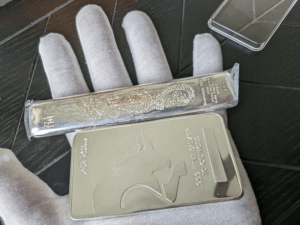
Image: Silver bars being handled with protective cotton gloves to prevent scratches and fingerprints.
Source: Reddit
Surface Protection
Skin oils and fingerprints create permanent spots on silver surfaces. Even brief contact leaves residue that attracts contaminants and accelerates tarnishing. Handle bars by their edges when possible, avoiding contact with flat surfaces.
Inspection Procedures
Check bars in good lighting without touching surfaces unnecessarily. Look for new scratches, spots, or discoloration. Rotate bars gently to examine all surfaces, using cotton gloves if extended handling is required.
Cleaning Protocols
Never clean investment-grade silver bars unless absolutely necessary. Cleaning removes microscopic amounts of silver and can create micro-scratches. If cleaning becomes unavoidable, use only distilled water and soft cloths, avoiding all chemical cleaners.
Home Storage Solutions vs. Professional Storage Options
The choice between home and professional storage depends on your security needs, access requirements, and insurance considerations. Before purchasing any 1-kilo silver bar for sale, consider your storage strategy to ensure proper preservation of your investment.
Home Storage Solutions
Safe Specifications
A quality fire-resistant safe rated for at least 1 hour at 1200°F can protect multiple 1-kilo bars. Look for safes with interior dimensions accommodating stacked bars with protective separators.
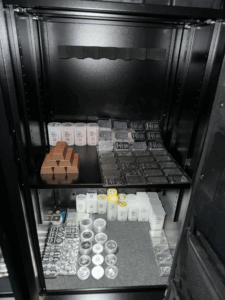
Image: Organized silver bars and coins stored securely inside a home safe.
Source: Reddit
Humidity Control
Basement storage requires dehumidifiers maintaining sub-50% humidity levels. Desiccant packets inside storage containers provide additional moisture protection, especially in garages subject to temperature swings. Replace or recharge desiccants regularly, since they lose effectiveness.
Organization Systems
Create inventory logs tracking each bar’s condition and location. Use protective sleeves or separators to access specific bars without handling others unnecessarily.
Security Considerations
Avoid obvious locations like master bedrooms. Consider multiple smaller safes rather than one large unit to spread risk and avoid drawing attention.
Professional Storage Options
Bank Safe Deposit Boxes
Most boxes accommodate 2-4 kilo bars comfortably, though not all banks permit bullion storage – check policies before renting. Access requires bank hours and dual-key procedures, limiting flexibility but providing institutional security.
Precious Metals Depositories
Segregated storage keeps your specific bars separate, while allocated storage pools bars with guaranteed quantities. Segregated costs more but ensures you receive your exact bars back.
Insurance Coverage
Professional storage typically includes comprehensive coverage, while home storage may require additional riders on homeowner’s policies.
Access Procedures
Professional facilities offer appointment-based access with detailed withdrawal procedures and identity verification requirements.
Common Storage Mistakes and Solutions
Even experienced investors can make storage errors that permanently damage their silver bars and reduce resale values. Proper care becomes essential when you understand why tangible assets play such an important role in wealth preservation. Here’s how to avoid the most common mistakes.
Moisture Exposure
Humidity above 50% creates irreversible tarnishing and black spotting on silver surfaces. Once these chemical reactions occur, the damage cannot be undone without removing silver material. Ideal storage maintains 30-40% relative humidity to prevent these chemical reactions entirely. Use dehumidifiers and moisture-absorbing packets to maintain dry storage environments.
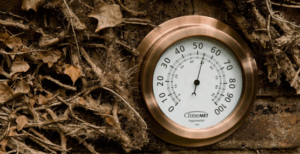
Image: Hygrometer measuring humidity levels, essential for silver storage environments.
Source: ClimeMET
Chemical Contamination
PVC plastics, rubber materials, and acidic papers release sulfur compounds that cause permanent discoloration. Avoid wrapping bars in plastic film, storing them on rubber mats, or keeping them in ordinary cardboard boxes. Instead, use archival-quality containers and inert materials designed for precious metals storage.
Temperature Fluctuations
Stable ~65°F storage is safer than perfect temperature targets with big swings. Fluctuations cause condensation that stresses packaging and promotes tarnish.
Overcrowding
Bars stacked without separators scratch each other during handling and settling. Allow space between pieces and use protective barriers to prevent metal-to-metal contact during storage and access.
Documentation Errors
Maintain detailed records including purchase dates, conditions, and photographs. For each 1-kilo .999 silver bar in your collection, document purity specifications and serial numbers for insurance and resale purposes. Insurance claims require proof of ownership and condition, while accurate documentation speeds resale transactions and establishes authenticity.
Long-Term Preservation Tips and Strategies
Successful long-term silver storage requires systematic monitoring and proactive maintenance to preserve investment value over decades.
Monitoring Schedules
Inspect stored bars every 6-12 months for new tarnishing, scratches, or environmental damage. More frequent checks risk unnecessary handling, while longer intervals allow problems to worsen undetected.
Condition Documentation
Photograph each bar from multiple angles when first stored, documenting serial numbers and any unique characteristics. Update records during regular inspections to track any changes in condition. These detailed records prove original condition for insurance claims and help establish authenticity during resale transactions, while serial number documentation prevents disputes over specific bar identity.
Preventive Maintenance
Address minor tarnishing immediately by improving storage conditions rather than cleaning bars. Identify and eliminate sulfur sources, adjust humidity levels, and upgrade protective materials before damage spreads.
Storage Upgrades
Invest in better storage solutions when collections grow beyond current capacity or when environmental controls prove inadequate. Quality storage pays for itself through preserved condition and resale values.
Estate Planning
Document storage locations, access procedures, and handling requirements for heirs. Include inventory lists, authentication details, and dealer contacts to ensure smooth transitions while maintaining proper care standards.
Conclusion
Proper storage transforms 1-kilo silver bars from vulnerable investments into preserved assets. Environmental control prevents irreversible tarnishing, careful handling maintains pristine surfaces, and systematic documentation protects insurance coverage and resale value.
For serious precious metals investors, 1 kilo bars offer an ideal balance of storage efficiency and manageable ownership. Their substantial size reduces per-ounce premiums while remaining practical for individual handling and home storage solutions.
Ready to buy 1-kilo silver bar bullion? Explore Blanchard’s selection of 1-kilo silver bars from trusted refineries like Johnson Matthey, Germania Mint, and other respected manufacturers.
FAQs
1. How much is a 1-kilo silver bar worth?
1-kilo silver bar price depends on current silver spot prices plus a modest premium over the raw metal value. The exact worth changes daily with precious metals markets, but kilo bars generally offer better value per ounce than smaller silver products.
2. How many ounces in 1-kilo silver bar bullion?
Each 1-kilo bar contains exactly 32.15 troy ounces of silver.
3. How big is a 1-kilo silver bar?
A 1-kilo bar measures approximately 4.5 inches long, 2.25 inches wide, and half an inch thick – roughly smartphone-sized but significantly heavier and denser.
4. How to store a 1-kilo silver bar safely?
Effective silver storage means controlling the environment and using the right materials. Keep humidity below 50%, maintain consistent temperatures, and avoid PVC or other sulfur-emitting plastics. Store bars with protective separators in a quality safe or consider professional facilities that provide stable, insured conditions.








